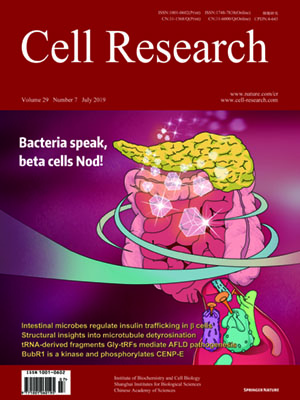
Volume 29, No 7, Jul 2019
ISSN: 1001-0602
EISSN: 1748-7838 2018
impact factor 17.848*
(Clarivate Analytics, 2019)
Volume 29 Issue 7, July 2019: 548-561 | Open Access
ORIGINAL ARTICLES
Complement C3 activation regulates the production of tRNA-derived fragments Gly-tRFs and promotes alcohol-induced liver injury and steatosis
Fudi Zhong1, Zhigao Hu 1,2, Keqing Jiang1, Biao Lei1, Zhan Wu1, Guandou Yuan1, Hongliang Luo1, Chunqiang Dong1, Bo Tang1,Chaowen Zheng2, Shuai Yang2, Yonglian Zeng1, Zhenya Guo1, Shuiping Yu1, Huizhao Su1, Guo Zhang3, Xiaoqiang Qiu2,Stephen Tomlinson4 and Songqing He 1,2
1 Division of Hepatobiliary Surgery, the First Affiliated Hospital of Guangxi Medical University, Nanning, 530021 Guangxi, China; 2Laboratory of Liver Injury and Repair, Nanning, Guangxi, China; 3Department of Gastroenterology, the People’s Hospital of Guangxi Zhuang Autonomous Region, Nanning, Guangxi, China and 4Department of Microbiology and Immunology, Medical University of South Carolina, Charleston, SC, USA
Correspondence: Songqing He (dr_hesongqing@163.com)These authors contributed equally: Fudi Zhong, Zhigao Hu, Keqing Jiang
Complement is known to play a role in alcoholic fatty liver disease (AFLD), but the underlying mechanisms are poorly understood, thereby constraining the development of a rational approach for therapeutic intervention in the complement system. C3 deficiency has been shown to impart protective effects against ethanol-induced hepatic steatosis and inflammation. Here we demonstrate a protection effect in wild-type mice by treatment with CR2-Crry, a specific inhibitor of C3 activation. The expression of glycine transfer (t) RNA-derived fragments (Gly-tRFs) is upregulated in ethanol-fed mice and inhibition of Gly-tRFs in vivo decreases chronic ethanol feeding-induced hepatosteatosis without affecting inflammation. The expression of Gly-tRF was downregulated in C3-deficient or CR2-Crry-treated mice, but not in C5-deficient mice; Gly-tRF expression was restored by the C3 activation products C3a or Asp (C3a-des-Arg) via the regulation of CYP2E1. Transcriptome profiling of hepatic tissues showed that Gly-tRF inhibitors upregulate the expression of sirtuin1 (Sirt1) and subsequently affect downstream lipogenesis and β-oxidation pathways. Mechanistically, Gly-tRF interacts with AGO3 to downregulate Sirt1 expression via sequence complementarity in the 3′ UTR. Notably, the expression levels of C3d, CYP2E1 and Gly-tRF are upregulated, whereas Sirt1 is decreased in AFLD patients compared to healthy controls. Collectively, our findings suggest that C3 activation products contribute to hepatosteatosis by regulating the expression of Gly-tRF. Complement inhibition at the C3 activation step and treatment with Gly-tRF inhibitors may be potential and precise therapeutic approaches for AFLD.
https://doi.org/10.1038/s41422-019-0175-2
FULL TEXT | PDF
Browse 1141


